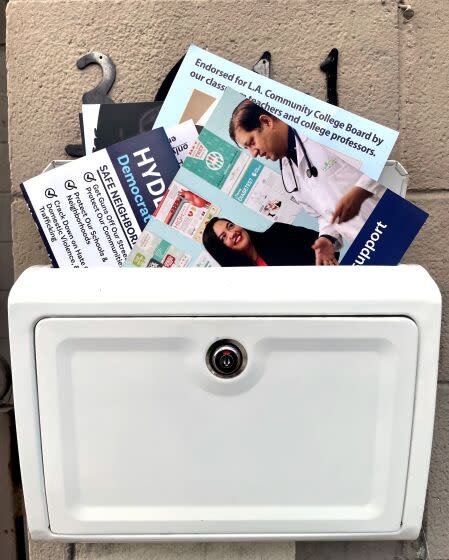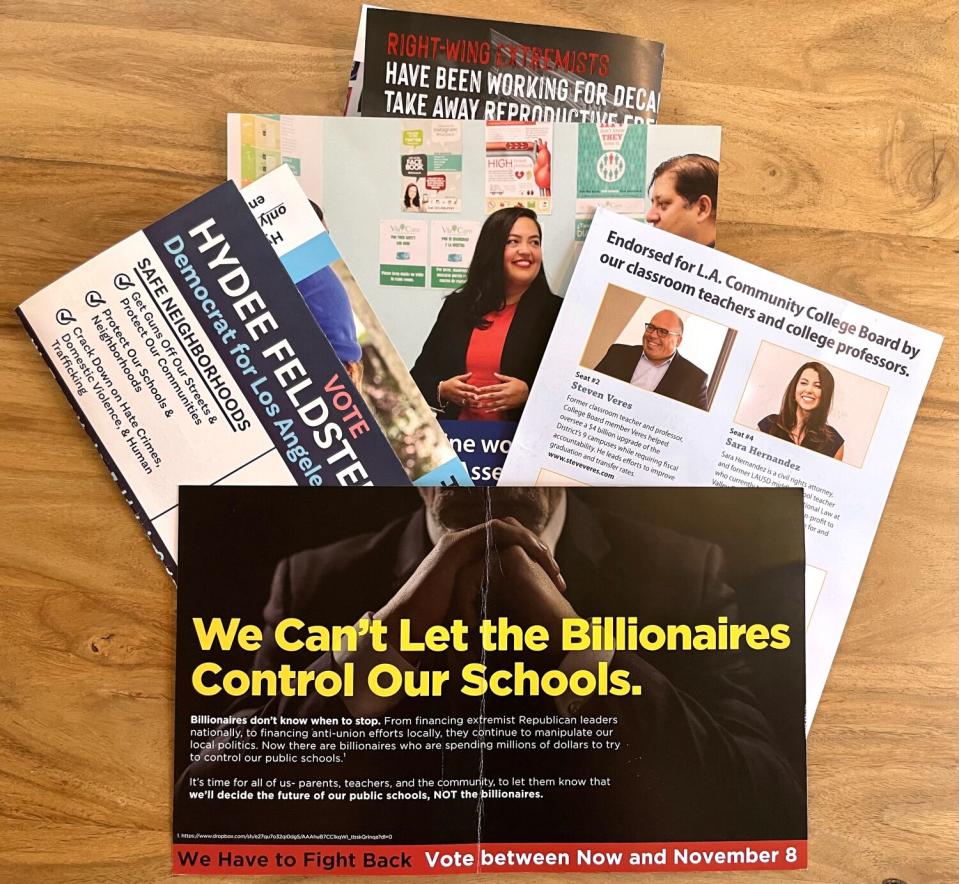Annoyed by those campaign fliers cluttering your mailbox? Here's how to make them stop

How can you tell it's election season? When you can see your mail before you even reach into the mailbox.
You know the sight.
An oversized cardstock flier for a school board candidate props open the mailbox lid, flanked by a trifold mailer with bold red, white and blue lettering that declares one city council candidate to be exponentially better than another.
And then there are the glossy half-sheets arguing for and against a proposition that sounds almost identical to another one.
You gather it all up and take it straight to the recycle bin, wondering if there's a way to save all the innocent trees that unknowingly sacrificed their lives on the altar of democracy.
So how do you make the campaign mail stop? There are a couple of ways to do it, but only one is guaranteed to work with most campaigns. And you'll likely have to wait until next election season to do that in time to make a difference.
People might not realize it, but when they register to vote, they are also opting in to receive campaign mailers. Names, addresses and more become part of a county's registered-voter database, which is public record.
"There are vendors all around the country who keep track of all that data, and then campaigns use that data," said Peter Ragone, a senior adviser to Rick Caruso's campaign for L.A. mayor. The appeal of direct mail is that it allows for specific targeting of individuals. TV reaches more people, but direct mail is more likely to hit the exact voter that a campaign wants to sway.
Data vendors also keep track of more than names, addresses and political affiliations. Among other things, they track whether a person votes by mail or in person, returns a ballot early or votes on election day, is a consistent voter or a spotty one. Campaigns then order up exactly the demographic they're trying to reach.
"We just provide the data and they have to provide the magic," said Paul Mitchell, vice president of business development for Political Data Intelligence (PDI), a company that sells curated California contact information to campaigns and others. "We do nothing that falls under the banner of consulting." (Full disclosure: PDI provides the lists the Los Angeles Times uses to conduct polling.)

While direct mail accounts for a smaller proportion of campaign spending these days, the total dollar amount spent on mail hasn't gone down, Mitchell said. "Campaign budgets have increased," he said.
It's possible that a direct-mail effort can be rushed through by a smaller campaign — Mitchell recalled a state senate campaign he worked on that put together an emergency 30,000-piece mailing in less than two days in response to a late-breaking attack ad — but a typical mailer usually takes five to seven days to go from PDF to printer to mailing house to the post office, he said. Lists can be ordered in advance or on the fly.
In the past 10 years, "California consultants have gotten much more sophisticated in targeting mail using the time factor," Mitchell said, referring to the data point about when people actually vote, given the uptick in voting by mail and early voting. A decade ago it was a "rare instance" when a campaign would send direct mail sooner to early voters and later to those who cast ballots on election day. "Now that is standard practice," he said.
But Elisabeth Schendel, a 30-year-old Sacramento resident who estimates she and her roommate were getting five to eight pieces of campaign mail daily until recently, thinks campaigns still don't really know how to reach people like her.
"We're millennials," she told The Times. "We don't really absorb information that comes in the mail."
She says she gets her election information via social media and her own "general curiosity": Schendel and her roommate do their own research online before filling out their ballots each election day, rather than checking out any of the fliers that show up in the mailbox.
"It's an overwhelming amount of mail, and with all of this coming in all at once, I'm less likely to look at any of it," she said.
But Rob Stutzman, a Republican political consultant based in Sacramento, disagrees with people who say they toss out campaign mail and don't pay attention to the campaign ads on TV. People like him measure campaign success by movement in polling or in the results on election day. They also use focus groups.
Stutzman said in a phone interview that he's seen many such groups where the first comments out of people's mouths are that they don't pay any attention to TV ads and they throw away all campaign mailers immediately. "Then, 20 minutes later, they're all describing why they don't like Candidate X because of exactly what was said in negative ads," he said. "It penetrates."
"What mail can do that other mediums can't is to be addressable to a person," he said. "It's the most targeted method of campaigning and that's why it's still in the tool kit. ... It's a tactile experience. It's more permanent than an interaction on a screen."

So how do you stop campaign mail from cluttering your mailbox?
Some might think the post office could help.
"The U.S. Mail serves as a secure, efficient, and effective means for citizens and campaigns to participate in the electoral process," Natashi Garvins, who works in media relations for USPS, wrote in an email. "We employ a robust and proven process to ensure proper handling of all political and campaign mail."
That's very patriotic, but are they as committed to not delivering political and campaign mail? Nope.
"If a customer receives an unwanted piece of marketing mail in their mailbox, they can contact the company(ies) and request their name be removed from mailing lists, request to be added to a 'Do Not Mail' list through the DMA, or simply throw it away," Garvins said.
The "do not mail" list is more accurately referred to as DMAchoice, a tool offered by the Assn. of National Advertisers, which in 2018 purchased the Data & Marketing Assn., which used to be the Direct Marketing Assn. (the DMA). The ANA doesn't supply the names for direct-mail lists, but its members include "many leaders in the direct marketing community," according to its website, and DMAchoice is a way to communicate preferences to that community.
One problem: DMAchoice is a means only to cut off the bulk mail that companies send to prospective customers. If a person is an established customer or donor, they have opened the door to direct contact from that company or fundraising efforts, and DMAchoice won't help.
But political mail falls into a different category, because it isn't aiming for your business, exactly. Campaigns want your vote.
There is one way that is mutually beneficial both to campaigns and to those who want to get out of the campaign-communication cycle, said Doug Herman, a lead strategist for Karen Bass' campaign for L.A. mayor.
"That's to vote and to vote early," so the vote gets recorded and those who traffic in data can pull your name off the list, Herman said.
It's not in a campaign's interest to spend money communicating with people who've already cast a ballot, especially if a candidate's war chest is running low.
But one problem with relying on your vote to cut down your direct campaign mail is there is always a lag between when a ballot is cast and when a county's voter list gets updated.
California's 58 counties all have different levels of efficiency when it comes to those updates, experts said, giving props to Los Angeles and Orange counties for their quick work. So there might be a brief delay between when a county updates its voter list and when a mailing-list vendor incorporates that update.
Also, because the assembly and distribution of physical mail is a time-consuming process, a mailer might go into production days or weeks before a person votes. Then there's the time in the mail, which varies based on geography and quirks in U.S. Postal Service practices. So voters might receive a mailer in the days after their ballot is cast.
Still, people who want to vote on election day can get their name removed from some campaigns' lists simply by asking. For example, someone who wants off Caruso's mayoral-campaign mailing list only needs to ask, according to advisor Ragone.
"We take people off the mailing list all the time if they ask," Ragone said. "We work really hard to be responsive to people" whether they call, email or even send a letter stating they don't want any more campaign mail. (Contact information is typically on the campaign's website.)
But, he added, "That doesn't mean we're perfect."
This story originally appeared in Los Angeles Times.

